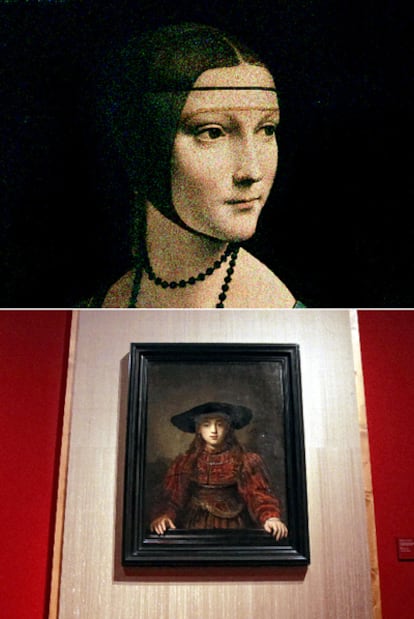The first lady of the Renaissance vists Spain
One of the brightest jewels in Da Vinci's oeuvre visits Spain amid major security operation
It could easily be the opening scene of a thriller with diplomatic-artistic ramifications: on Monday, May 30, a military plane flying in from Poland will land at the Torrejón de Ardoz base at precisely 4pm. From that moment on, a team of 12 people ranging from art restorers to politicians will watch over a pictorial gem of incalculable value. The treasure that merits such attention is none other than Lady with an Ermine, one of the most outstanding paintings in Leonardo da Vinci's small artistic production, and, as such, one of the crown jewels of Italian Renaissance art.
Lady with an Ermine, painted around 1490, will be the star exhibit in La edad de oro de Polonia (or Poland's Golden Age), which opens on June 3 at Madrid's Palacio Real. The show is sure to be one of the biggest art events of the season, since it is uncommon for such emblematic artworks to travel. After stopping in Madrid, the painting will go to Berlin and to London's National Gallery, after which it is scheduled to return to Poland and remain there for at least another 15 years.
But before that, the lady must meet her obligations in Spain. The canvas, which measures 54.8cm by 40.3cm, will occupy one of the Spanish palace's noble rooms, which has been especially fitted to host a painting that revolutionized portraiture for a variety of reasons, including the spiral-like movement that makes its way up the sitter's head, the anatomical study of her hands, face and neck, that almost tangible air about her (the famous sfumato shades without lines) and, above all, her harmonious and undying Renaissance beauty. Not to mention that large and sublime hand.
A team of specialists in bullet-proof glass products are building a display case to hold the painting, whose trip is costing the three host countries a joint ¤30,000. Anything to preserve the integrity of a masterpiece that has already survived two world wars, Nazi looting and attempts to deface it, to reach today's public in excellent conditions.
A miracle? Nicolás Martínez-Fresno, president of the National Heritage trust, would rather reserve that word for the fact that Lady with an Ermine is coming to Spain at all. Prime Minister José Luis Rodríguez Zapatero, Culture Minister Ángeles González-Sinde and even King Juan Carlos all intervened to make this possible. The monarch viewed the painting in Washington a few years ago, and he personally knows Prince Czartoryski, the singular owner of the artwork and of the rest of an incredibly valuable collection housed in Krakow's Czartoryski Museum.
"The story of this painting has run almost parallel to the history of Poland," explains Martínez-Fresno, in reference to its discovery in the catacombs of a Polish castle in 1939 and its subsequent seizure by Nazi invaders, who packed it away to the Kaiser Friedrich museum in Berlin. In 1940, Hans Frank, governor general of occupied Poland, demanded that the painting be returned to the city of Krakow, which ultimately meant that it ended up gracing the walls of the military official's own private villa.
But before the eventful 20th century came around, the story of Lady with an Ermine had begun in Milan, where Leonardo painted it at the request of Duke Ludovico "The Moor." The lady in question is Cecilia Gallerani, the duke's young mistress, portrayed at around 17 years of age. Leonardo himself was a little over 40.
Successive restorations did not touch the young woman's figure, but did affect the background. We know that the darkness we see today was not there originally. Nor is the signature that appears in the upper left corner. And what about the ermine? The animal provided the duke with his surname, but some controversy exists as to whether the creature in the painting may in fact be a weasel, a ferret or even a marten.
Zoological disputes aside, the enigmatic pet and its owner will remain in Madrid until September, together with 190 other artworks that bear witness to the breadth and depth of Poland's museum holdings, which include paintings by Lucas Cranach and Rembrandt.








































